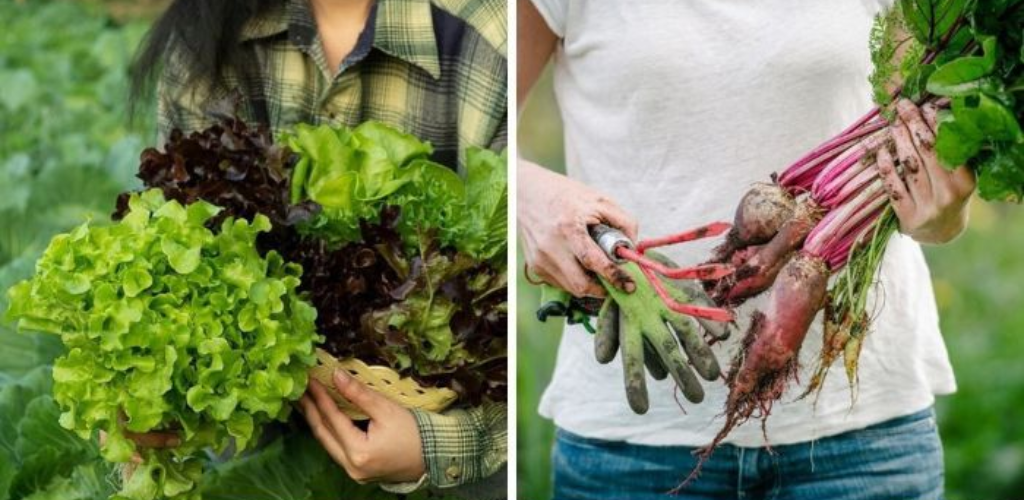12 Winter Garden Vegetables – The Complete List of What You Can Grow
There is absolutely no reason for the growing season to stop just because winter begins. There are quite a few winter garden vegetables that grow well in cold weather. In fact, some vegetables thrive in cold weather and will ultimately taste better.
Here is the complete list of vegetables to grow in winter, along with some tips to keep your winter garden happy and healthy.
First, educate yourself on the climate in your region. Find out the average winter temperatures in your area. You will be able to tell how a typical winter will hold up for you.
The lowest temperature in your area is how you choose what you can grow. This temperature is the limit of what you can grow unprotected in your vegetable garden.
Remember that one of the advantages of growing winter vegetables in containers is that they are mobile. So, if the weather is really bad, you can simply move your garden to a protected area.
Ultimately, there are three types of winter garden vegetables: hardy, semi-hardy, and “ultra-hardy.”
Hardy vegetables:
Hardy vegetables tolerate hard frosts that occur at about -2 to 4°C. In areas where temperatures drop, you will need to provide protection throughout the winter.
Hardy vegetables include peas, kohlrabi, leeks, broccoli, Brussels sprouts, radishes, turnips, and cabbage.
Semi-hardy vegetables:
Semi-hardy vegetables tolerate light frosts, defined as frosts that occur at 0 to -2°C. Semi-hardy vegetables are not as tolerant of winter temperatures as hardy vegetables, but they can still grow very well in many winter climates.
Curly lettuce, arugula, Asian greens, endives, chard, beets, and carrots are all examples of semi-hardy vegetables.
Ultra-hardy vegetables:
Finally, we have what we have called “ultra-hardy vegetables.” There are only three ultra-hardy vegetables: kale, spinach, and mustard greens.
These three crops can tolerate temperatures as low as -6°C and up to 15°C for kale. In milder regions, they will literally grow all winter, right up to the following spring.
Below, we have included a list of 12 of our favorite winter garden vegetables.
1) Peas
Plant peas in November or February for a good winter harvest. Plant seeds 2 to 3 cm deep in the garden soil and be sure to include a trellis or something for the plants to climb and wrap their tendrils around.
Tip: Birds love peas, so you may need to cover the sprouts with a tarp or floating blanket. Make sure sun and rain can get in!
2) Radishes
Radishes are low maintenance and grow very quickly. Some small root varieties are ready in a month or less after planting! These roots are nice to cold temperatures and young growers.
3) Leeks
Leeks are inexpensive crops that produce abundantly. As hardy greens, they are unfazed by mild winters, although they do require a little attention in extremely cold climates. They can be harvested year-round and are a staple for soups.
4) Salads
Lettuce varieties are semi-hardy, meaning they are suited to milder climates. Look specifically for varieties that enjoy the cold. Mesclun, heirloom, and red leaf are particularly interesting choices. Sow seeds in January and February, use a row cover, and enjoy a spring harvest.
5) Spinach
Spinach is one of our ultra-hardy crops, meaning it grows in all types of climates. Ideally, sow in early fall and harvest all winter. If you’re lucky, your harvest will extend into next summer.
Tip: Remove flowers regularly to prevent your spinach from going to seed.
6) Potatoes
February is the perfect winter month to plant potatoes. You’ll harvest about 3 months from the planting date. It’s a hearty winter starch, and it’s incredibly satisfying for kids to harvest root vegetables.
7) Kale (Kale)
Kale is another ultra-hardy vegetable, and it’s made much more tender and flavorful by the cold. Find the full guide to growing kale here, and how to extend your harvest into winter on-site.
Note: It’s easier to grow seedlings!
8) Winter Herbs
There are some herbs that grow well in winter, such as rosemary, thyme and mint, but all herbs become winter herbs when grown indoors. Herbs grow extraordinarily well indoors on windowsills.
